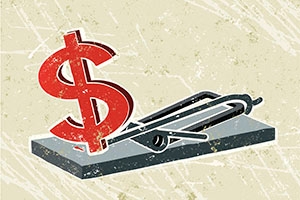Business
Pitfalls and Profits: H. Kent Baker Co-Authors Book Exposing Investment Traps

With so much quality scholarship published every year, it’s easy to get overwhelmed. But the new book co-authored by American University’s H. Kent Baker should not only expand your mind, but help you save a significant amount of money. Baker and Vesa Puttonen, a finance professor at Aalto University in Finland, recently released Investment Traps Exposed: Navigating Investor Mistakes and Behavioral Biases (Emerald Publishing).
It’s a highly readable overview of personal financial management, and it’s largely aimed at a general audience. So, if you’ve been kidding yourself for years that you understand terms like “leveraged ETFs,” Investment Traps Exposed can be quite valuable. Yet even for people with business experience and economics degrees, the book has much to offer.
“We think it will be beneficial to many investors. It can help create awareness, and help them make better financial decisions,” says Baker, a university professor at AU’s Kogod School of Business. “If people follow what we suggest, they have the potential to fall into far fewer traps, make fewer mistakes, and avoid those biases that can be hurtful.”
Financial Literacy and Scams
In the book, they write about scams and pyramid schemes that can hoodwink innocent people in the market. Bernie Madoff ran a notorious Ponzi scheme, and Baker says even some experienced investors got sucked into his web of deceit.
People tend to assume it’s only old people and less educated investors who get conned, but Baker says that’s contradicted by data research.
“You find many people who are very knowledgeable get pulled into these investment scams. Why? Because the scammers on the other side, they’re really marvelous—if I can use that term for them—at manipulating people,” Baker says in an interview.
However, if you learn about financial markets, you’re generally better equipped to handle your money. As Baker stresses, gaining financial literacy is imperative. But that takes time and energy, and it sometimes requires more money.
The book details various kinds of financial advisers and brokers, and there are pros and cons of any type of professional you hire. Some brokers operate on commission, and they have a personal stake in having you make more transactions. But a fee-based adviser charges a percentage of a client’s “assets under management,” meaning that adviser has less incentive to ask people to make risky investments.
“I’m not castigating all brokers, but brokers are held to a different standard than you’ll have with someone who happens to have a Certified Financial Planner designation,” he explains. “The CFP uses a fiduciary standard, so they have to make decisions that are going to be in your best interest. Brokers are often held to a suitability standard that says, ‘We have to do something that is going to be suitable.’ Well, something that is suitable is not necessarily in your best interest.”
The ‘pay money to save money’ notion is a tough sell for many financially-squeezed Americans, but this book includes a salutary quote from oil well firefighter Red Adair. “If you think it’s expensive to hire a professional to do a job, wait until you hire an amateur,” he said.
All Kinds of Biases
Yet even if people are informed about financial matters, they’re still susceptible to bias. The book examines some of the biases—cognitive, emotional, and social—that can lead people to make unwise investments. With social biases, a person might latch onto the investments du jour favored by their friends and neighbors. One form of this is herding, the groupthink that helped set off the 2007-2008 subprime mortgage crisis.
“When the market has been going up—which it certainly has been in recent years—people will look at that and say, ‘Gee, I want to get in on that rise,’” says Baker. “They’ll often jump into the marketplace when the market is high, and that’s really the worst time to get in. You want to buy low and sell high, not the other way around.”
Planning for the Future
Likewise, it’s important to be aware of your biases before you invest. And, as Baker notes, even being cognizant of those biases won’t necessarily keep you from repeating the same mistakes. That’s where planning and forethought can help you stave off your worst tendencies.
Strategic planning is a vital part of this process, he says. They recommend devising an “investment policy statement,” while figuring out how much risk you’re willing to tolerate. For example, he says, you might plan 40 to 60 percent of your portfolio to be in stocks. If one of your investments is rising fast—with stocks comprising 75 percent of your holdings—you’ve gone beyond your initial risk ceiling and should rebalance your portfolio.
“But most people will not do that. They’ll say, ‘Wow. I’ve gone ahead. Look at how well these stocks have done. I’m not going to get rid of them,’” he explains. “Getting rid of a certain portion of your portfolio that’s done well is going to seem counterintuitive. But that’s what you should do.”
In other words—despite what Gordon Gekko thinks—greed is not always good.
One theme that surfaces in the book is the problem of “short-termism.” People spend now or seek immediate profit, while ignoring the long-term implications of those decisions. Yet if new AU graduates enter the workforce, Baker recommends they do one thing quickly: set up a 401 (k) or other retirement account. Otherwise, they’re leaving employer contributions—essentially, free money—on the table.
“You want to start early. And one of the reasons for that is because of the compounding effect of money over time,” he says. “It can make huge differences for individuals for decades.”
